

© Shipping Wonders of the World 2012-

Building a Liner
When the architect of a vessel has finished his preliminary work the construction begins, entailing skill and labour that may endure from six months to six years
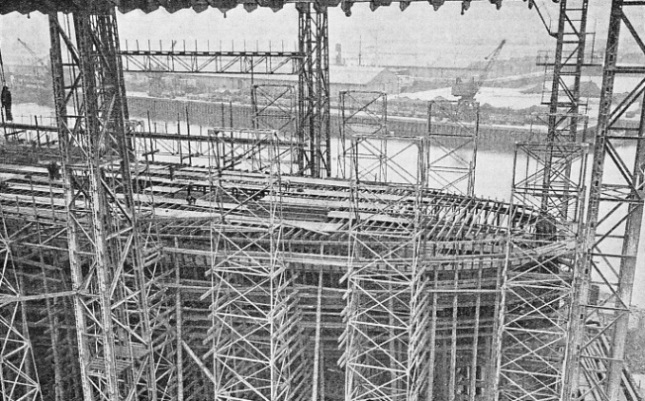
FROM SLIP TO SEA. The several stages by which a ship grows after the laying of the keel are diverse yet strictly chronological. After the keel plates have been laid the transverse members or “floors” are placed into position; then the frames are fastened to the tank sides, plates are hung in position and riveting of the hull begins. Different categories of workmen continually follow one another through the ship: carpenters, platers, riveters, caulkers, testers and painters, and then carpenters again for the launch. Out of this work of an army of men grows the trim form of the modern vessel. Above is a view of a liner’s stern being built up, with the hull taking shape.
THE first stage in the construction of a ship begins with the laying of the keel in the shipyard, a function which may or may not be accompanied by ceremony, according to the nature of the ship and her subsequent duties. It continues until the time of the launch.
The launch marks the end of stage one and the beginning of stage two -
With the exception of the launch, stage three is the most important and anxious of all from the point of view of the naval architect. It is the trial trip, for then the ship must prove herself; she must make the speed which the design conditions have laid down; she must make it, furthermore, at a certain draught and with a certain specified fuel consumption in pounds per horsepower developed per hour, or in tons of fuel used per twenty-
The fourth stage is concerned with the active life of the ship and may vary from a mere eight or ten years in the life of a hard-
The final stage of which we can speak is the “death” of the ship. She then passes into the ship-
The theoretically complete shipyard even to-
Before the War of 1914-
Changing economic conditions have now ruled out all that. There are many shipbuilding companies in some way or another financially associated with steel companies. For this reason they buy the products of those steel companies, but few of them are self-
Our purpose here is to discuss the development of the ship from the laying of the keel to the delivery to the owners. We will omit for the moment any particular study of means by which the iron ore becomes pig-
The most primitive form of power-
Importance of Building Berths
The modern ship is a development of this, and her open cargo-
Longitudinal strength in the vessel is secured partly by the rigidity of this double bottom and partly by the presence of longitudinal girders, which are known as side or deck stringers according to their position in the ship. Pillars are also used to support the deck structure and to aid in giving transverse rigidity to the hull.
Ships cannot be erected at random anywhere near water. They are built on ground which is specially prepared and which often has been used for the purpose for as many as upwards of one hundred years. The building berth is in some ways the most vital factor in the construction of a ship, for it has to take a continually increasing weight of hull structure.
More important still, it has to take the weight of the structure and support the hull members, the floors, frames, and the like, when they are in a relatively “plastic” state one to the other. The ground must therefore be solid, not liable to subside under weathering, or when heavy weights such as large castings are put into position on the structure. Any shifting of the ground not only means endless work in putting members back in their relative positions, but it may also entail serious distortion to the hull of the ship. For this reason, naval architects are always anxious when there is any postponement in the construction of a vessel that has been begun, particularly if the vessel’s hull is not completely plated, i.e. made rigid.
Building berths are generally piled in way of the blocks on which the hull structure is built, some piles being as much as 15-
The berth naturally slopes down into the water. Piling is exceptionally heavy at this point because, during the launching of the ship, it is at the end of the berth that the concentration of weight is at a maximum, since the hull slides over the end of the launch-
Another essential feature for a good building berth is that it should be efficiently and adequately supplied with cranes for placing the various members of the ship’s structure in position during construction and for slinging up deck and side plates. How it is done is well shown in the accompanying illustrations.
Naturally, different countries and shipyards employ individual methods for the handling of material. Space does not here permit of a detailed discussion of the various arrangements, but from the illustrations some idea will be gathered of gantry cranes, cantilever cranes, closed-
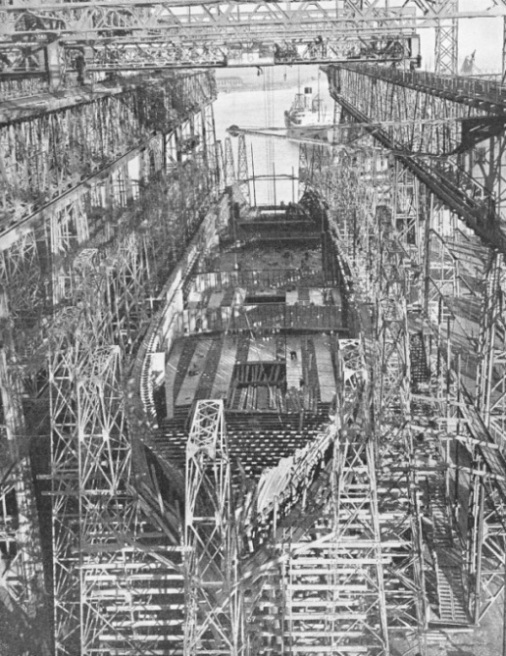
A NEST OF STEEL. The illustration shows the giant Cunard White Star liner Georgic (27,759, tons) in course of construction, surrounded by cranes and scaffolding. The double bottom forms the backbone of the vessel, and the side frames or ribs are bound together with transverse beams placed in position after the frames have been arranged. One of these can be seen being lowered into place by the crane in the foreground. At this stage work on the deck plates has begun, and the transverse watertight divisions or bulkheads can clearly be seen. Many apertures are left -
It should be emphasized, however, that a good building berth and a good lay-
In a busy shipyard, the launching of one vessel is followed almost immediately by the laying of the keel for another. If we assume that a vessel has just been launched and that the berth is to be occupied by a new ship, we shall note that the first operation is to sort out the building blocks left in a rough-
Building blocks are made of baulks of timber, pitch-
Ships are always built on a declivity to the berth, generally nine-
In a modern ocean-
The complete set of keel plates is taken one by one to the building berth and each plate is lifted on to the blocks by the overhead cranes previously mentioned, being lowered into its proper place according to the sequence numbers. Each plate is joined to its neighbour by means of a butt strap -
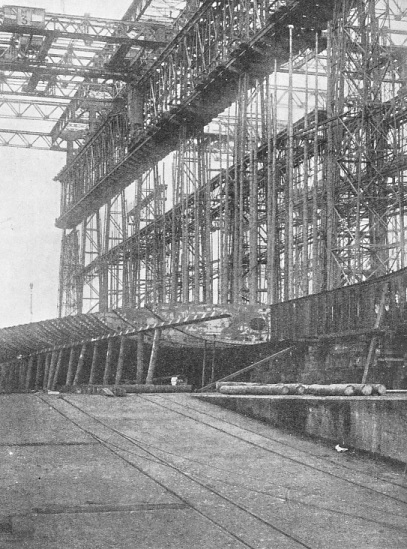
BUILDING THE BACKBONE. The first plates of a ship are those forming the keel, which forms the basis of the hull. The vertical keel seen in this photograph is laid on the slipway which slopes towards the aft end of the vessel, and leads to the water into which she will eventually be launched. The illustration gives a clear idea of the ship’s double bottom, with its sub-
The keel plates are all “centred” on the blocks by the shipwrights, who make sure that the keel is straight, end for end, and that it is tolerably level, i.e. that there are no bumps throughout its length. Although the keel plates are now in position and bolted together, the whole keel is by no means rigid, but, as soon as it has been laid and levelled, it is riveted. The fore and aft angle bars for the vertical keel are then bolted into position. An angle bar is, as the name indicates, a long length of steel sectioned as a right angle. It is an excellent means of joining one member to another when holes are punched in either side of the angle.
After these angle bars have been placed in position a start is made with the placing in position of the vertical keel. This, with the flat plate keel, forms the backbone of the ship. It has other angle bars attached at the top, and vertical ones on either side. It is to these vertical angle bars that the floors, as they are called, are next attached. These are the vertical thwartship members which at the ship’s centre are the same depth as the height of the vertical keel. When plating has been placed underneath them, on top and along the sides, they form the ship’s double bottom.
This double bottom is one of the most important features of ship construction. It is a receptacle for water ballast, for liquid fuel, and for lubricating oil. It also acts as a powerful protection against damage, should the ship ground; for it means that even if the outer bottom, as it is called, is pierced, the vessel can still float on the inner bottom or tank tops. The floors are generally lightened by means of manholes which are punched into them. The manhole, as the name indicates, is a hole made in the plate, of flat oval section, and generally of sufficient dimensions to allow a man of ordinary size to crawl through. In addition to lightening the plate, the manhole also has the effect of making the tank capable of carrying liquid. Where it is desired to complete a tank, then the floors are solid, i.e. they have no manholes in them.
Our “members” now comprise a flat plate keel, vertical keel and floors. These floors have to be kept at the right distance, the one from the other, by means of other plates which are called inter-
We now have the main fore and aft skeleton or backbone of the ship. It remains only to add what the old shipwrights knew as the ribs, i.e. the frames. These are made of one or another of various sections -
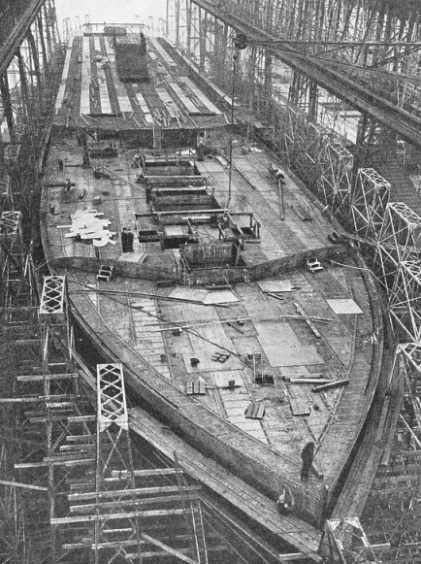
AFTER THE BACKBONE has been built work is begun on the decks, side-
The frames themselves, according to the type of ship, are either straight up and down or curved. In any event, they generally curve at the bilge of the ship, i.e. the rounded portion between the outer bottom and the ship’s side.
The most modern passenger-
By this time a start has been made with placing the shell plating in position. Several of the deck plates have also been “laid”; but the plating of the deck is not complete, for many apertures have been left, the biggest one being for the machinery. Unless the ship is a tanker or some special vessel, this is placed amidships.
There are also other apertures corresponding to the cargo holds. The number of tiers of beams will depend upon the number of decks in the ship, eight or nine in the largest ships. If the vessel is a large passenger liner, a start will now have been made on the superstructure. As soon as some of the decks are plated it is even possible that a start will have been made with the laying of the wood and with the bedding down of items of deck auxiliary machinery such as the anchor windlass and winches.
Ready for the Launch
While all this constructional work has been going on, the big castings for the stem and stern frame will have been lifted in position and will now be incorporated in the hull itself. If the ship is a twin-
The different categories of workmen are continually following one another throughout the ship. The carpenters have been first, with the platers, to lay the keel and see that the preliminary members of the ship are in place. More platers have followed the carpenters, the riveters are following the platers, and the caulkers are following the riveters. The task of the riveters is to see that the plates are watertight. The caulkers are followed by gangs of testers, to test the tanks for water-
The launching of a ship is a highly specialized performance and will form the subject of another chapter. Suffice it to say, by now, however, that the vessel will be sufficiently riveted, caulked and made watertight for consideration to be given to her entry into the water. She slides down the ways into the water, floats at a very light draught successfully, is taken in hand by tugs, and towed alongside the fitting-
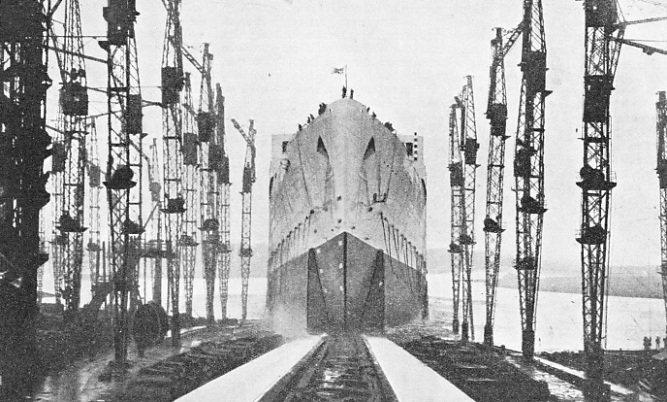
A CRITICAL MOMENT in the launch of a large liner, when the fore-
In many ships a start may already have been made on this when the ship is on the stocks. In Italy, where they launch into a tideless sea, they sometimes put their vessels into the water complete in every detail, and some ships have been known to be launched with their machinery ready for operation, and then to steam or motor away on their trial, trip complete. This, however, is the exception rather than the rule. Even should the boilers be in place -
Once this has been done, the work on the equipment of the ship will have been pressed forward to such an extent that little remains to be done but the putting on board of the equipment. This includes boats, lifebelts and the like, and the finishing off of the joiner work in the cabins. After this the ship will be ready for the first of her many important ventures -
The ships that are constructed most quickly are generally excursion vessels intended for carrying passengers on coastal trips during the summer months.
Speed of Construction
Owners generally place their orders about the beginning of December, and expect to have delivery before the following Whitsun. A ship of this kind, which is anything up to 250 feet in length, normally requires seven or eight months for construction. Sometimes this period has to be compressed into five, because the owner does not place his contract exactly when he should.
The speed of construction on any vessel depends upon the arrangements followed in the shipyard. A works that is well laid out permits of the construction of such integral parts of a ship’s hull as the complete frame sections and bulkheads on the ground at the head of the slipway. Thus a complete ship can be prepared by the platers, the frame turners and the shipwrights in such a way that the erection is the swiftest part of the whole performance. This requires, however, careful organization and attention to detail. If the vessel is to be put together in a hurry, every part must be exactly correct, even to the position of rivet holes and so forth, and no time is available for the adjustments which are sometimes made during a more leisurely process of building.
The strangest process in the whole ship construction is that employed in certain craft for work in the tropics. For here the complete ship is built in a yard in Europe, bolted together, then dismantled, each part being carefully numbered, placed on board another vessel and shipped to its destination.
In some instances paddle-
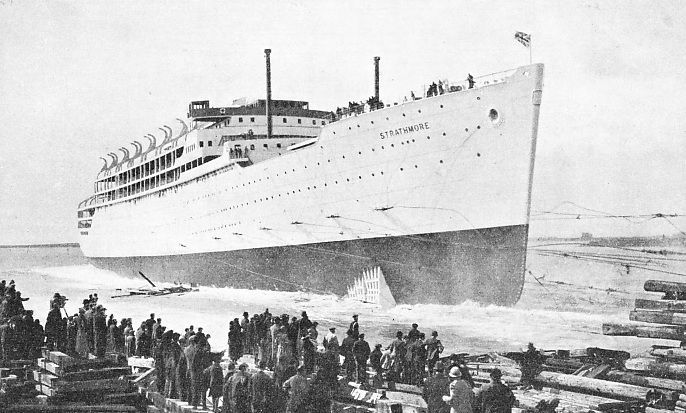
ONE OF THE FINEST SIGHTS in the world, the launch of a great ocean-
You can read more on “Launching Ceremonies”, “The Shipbreaking Industry” and
“RMS Strathmore” on this website.